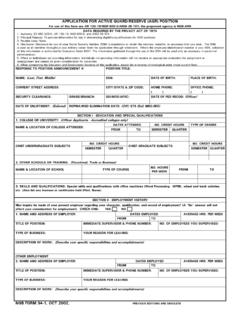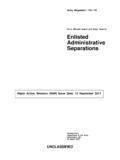Transcription of Using Guard Animals - Because Wildlife Matters
1 1 UsingGuard Animalsto Protect LivestockMissouri Department of Conservation2 Equal opportunity to participate in and benefit from programs of the Missouri Depart-ment of Conservation is available to all individuals without regard to their race, color,national origin, sex, age or disability. Complaints of discrimination should be sent tothe Department of Conservation, Box 180, Jefferson City, MO 65102, or Fish& Wildlife Service, 18th and C Streets NW, Washington 20240, Missouri RelayCenter 1-800-735-2966 (TDD).Copyright 1996 by the Conservation Commission of the State of of livestock Coyotes ..4 Wild and free-running domestic dogs.
2 5 Types of Guard Guard dogs ..6 Training and Potential benefits with Using Guard Potential problems with Using Guard When problems Guard donkeys and mules ..9 Training and Tips on Using Guard donkeys or Guard llamas ..11 Training and Potential benefits to Using Guard Potential problems with Using Guard Multi-species grazing ..12 Group Feeding more : Jim BraithwaitIllustrator: Diana JarrellDesigner: Libby BlockEditors: Gene Kelly and Joan McKee4 INTRODUCTIONEach year livestock producersacross the United States lose mil-lions of dollars from predator attackson their cattle, sheep and are the main cause of live-stock deaths followed closely bywild and domestic best way to protect livestockfrom these canine predators is totake a preventative approach.
3 Formany Missourians, Using Guard ani-mals, such as dogs, llamas and don-keys, have helped cut their booklet is designed to help live-stock producers decide if thisapproach will work for for predators, however,takes a variety of control is no one technique, nor willthere likely be one, that will solveevery producer s who are successful use anintegrated approach, combininggood husbandry practices with elec-tric fences, Guard Animals , goodherders, trapping, shooting ormechanical scare devices. They alsomust be flexible enough to use what-ever combination of methods solvesthe problem. This has to be the casebecause predators always have andalways will be a part of the livestockproducers OF LIVESTOCK PREDATORSne of the best ways to stop pred-ators from preying on livestockis to understand the habits andbehavior of the Animals that arecausing the problem.
4 By under-standing their needs, it may be easierto control their 1977 to 1987, the coyote pop-ulation increased rapidly in Mis-souri. These highly adaptable ani-mals are often viewed only aslivestock predators. They are, how-ever, important members of thewildlife feed mostly on Wildlife ,which includes rodents that oftencause damage to fields and also prey on old, sick andinjured Animals . As a scavenger ofboth wild and domestic Animals ,they are a major factor in main-taining healthy Wildlife populationsand in cleaning up the to a study of Missouricoyotes by research biologistsCharles and Elizabeth Schwartz, live-stock accounts for less than 9 percentof the coyotes total diet, which indi-cates that these predators aren tcausing as much trouble to farmersas many people believe.
5 Still, coyotesdo occasionally kill livestock. Lambsare particularly Iowa study revealed that 46percent of all livestock losses arefrom nonpredator causes, such asdisease and starvation, while caninepredators, such as coyotes and dogs,are responsible for 41 percent of live-stock loss. Thirteen percent of thelosses in the study were fromunknown Columbus came ashore in1492, coyotes lived in about one fifthof the North American their range has extended fromAlaska through all but the northeastportion of Canada, and throughoutthe continental United States andMexico. The coyote is found in themythology of most Indian tribes fromthe Athabasken and Cree of northernCanada to the Mixtec of southernMexico, which indicates its diversityand widespread of the reasons for its survivalis its ability to adapt to the changingenvironment.
6 The coyote has provento be much more capable at sur-O5viving around people than some ofits past competitors, such as the tim-ber wolf. As the timber wolf wasextirpated from much of its formerdomain, the more adaptable coyotefilled the vacant niche. The red wolfalso wasn t able to live in close prox-imity to people. As the red wolves numbers decreased, the coyote tookover its range, too. Interbreedingwith coyotes also helped dilute thered wolves gene wolves, which are nowextinct in Missouri, used to be thecoyotes main predator. Today thatrole has been taken over by are trapped and huntedthroughout the state and are valuedfor the durability and beauty of theirlong fur.
7 In the Ozarks, huntingcoyotes with dogs is a long and free-runningdomestic dogsWild and domestic free-runningdogs are the second leading livestockpredator. Feral dogs are a problem insome areas, but are far less commonand are less of a problem thandomestic domestic and feral dogs tendto run in packs, and they can doextensive damage to by dogs can be distinguishedfrom those by coyotes. Dogs usuallyattack wherever they can get a holdon the animal . They often bite thehindquarters, causing severe tissuedamage. Coyotes, on the other hand,usually go for the by dogs may appear to bedone as a sport rather than as ameans of survival. Dogs often killseveral or all of the livestock in anarea or pen and may abandon theirkill without feeding on will chew on legs, ears andtails and often mangle the animalsrather than killing them.
8 Coyotesusually will kill only one animal andwill take it off to be eaten. Most dogs that cause damagebelong to someone. Never dismissdogs as a potential predator justbecause you haven t observed feraldogs in the area. The attacker couldvery likely be a neighborhood dog oreven the family coyote s scientific nameis Canis latrans, which comesfrom canis, the Latin wordfor dog, and latrans, the Latinword for barker. The com-mon name is from the AztecIndian word dietA study of Missouri coyotesshowed that they eat a variety offood. Here is a list of what wasfound in the stomach of 770coyotes and the percentage byvolume:Rabbits .. and rats .. wild Animals .. birds.
9 FROM The Wild Mammals of MissouriBY CHARLES AND ELIZABETH SCHWARTZC oyotes help farmers by keeping downthe populations of mice and Missourians protect theirlivestock with the help of guardanimals. There are advantages anddisadvantages to Using each type ofguard animal . The following infor-mation should help livestock pro-ducers decide if an animal would bea valuable asset to their dogsTrained dogs have been used to pro-tect sheep and goats from predatorsfor many centuries in Europe andAsia. However, acquiring a dog usu-ally is not a quick solution to a pred-ator a puppy to become amature and effective guardianrequires considerable time, effortand good fortune.
10 In spite of a lot oftime spent in training, some dogswill never be effective at stoppingpredators. In some cases, a dog maybe all that is necessary. In others,dogs may be used to supplementelectric fencing, trapping, hunting orother forms of is important to understand thedistinction between herding dogsand Guard dogs. Herding dogs workaccording to verbal and hand signalsfrom a handler, and they are gener-ally not left alone with dogs usually do not are discouraged from biting,chasing and barking atlivestock, and they actindependently of ideal Guard dog isintelligent,alert andconfident. Itmust act inde-pendently andinstinctivelywhile pro-tecting theflock or herd.






